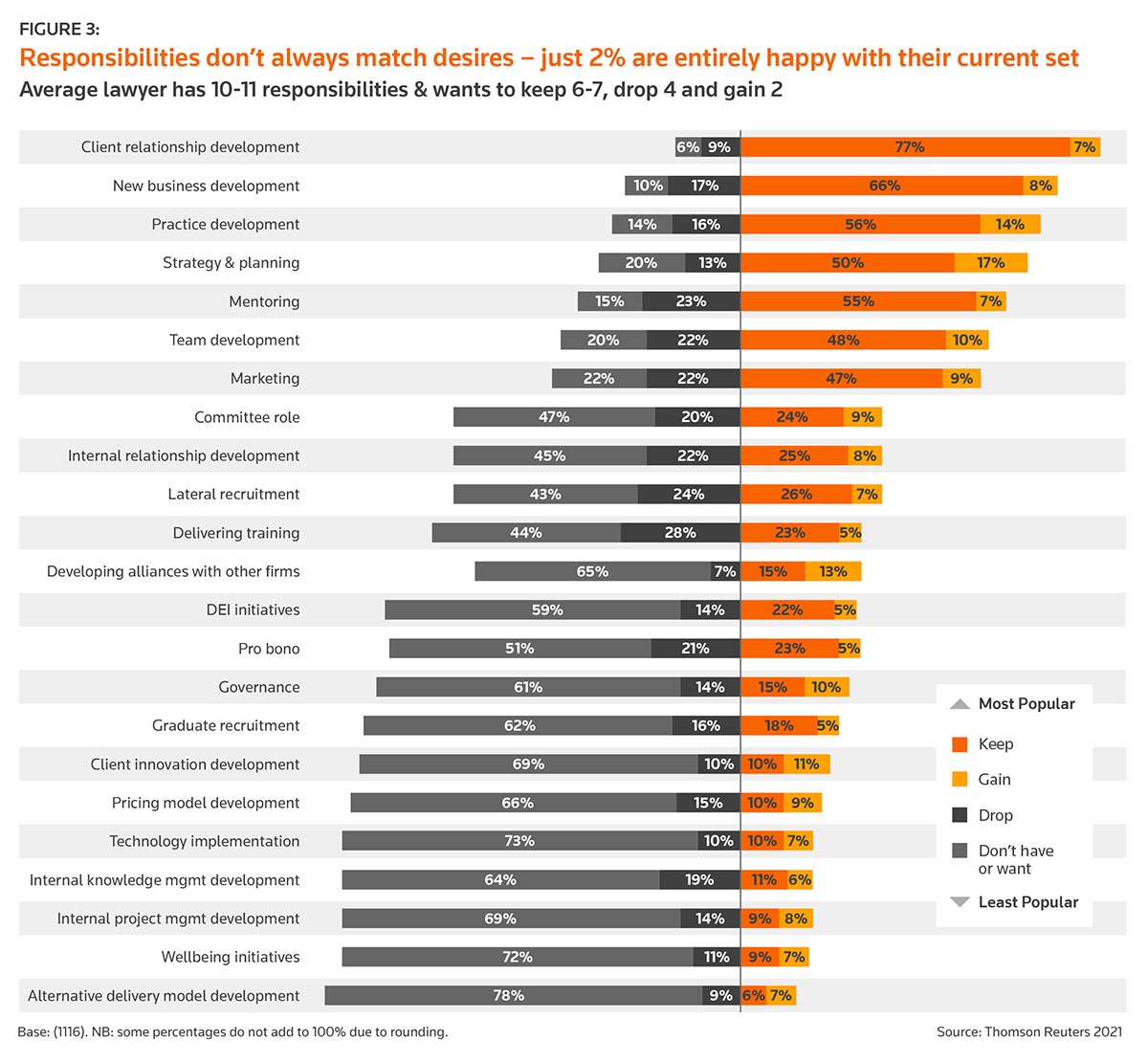How happy are lawyers with the work they’re doing on a daily basis? Well, according to our latest research, that all depends on what work they are doing
Just 2% of lawyers from our global database of almost 1,200 client-nominated attorneys (Stand-out Lawyers) are completely happy with their set of non-billable responsibilities, according to the Thomson Reuters Institute’s Stellar Performance: Skills & Progression Mid-Year Survey. The survey also points out that lawyers have said they are responsible for an average of 10 different non-billable activities in their jobs.
This has created some troubling implications for law firms’ talent strategy because some of the biggest areas in which partners prefer not to be involved are people related, such as delivering training and aiding in lateral recruitment.
To illustrate this further, we charted out the activities that lawyers desire to do more, keep the same, and those in which they would like drop their involvement. In the graph below, red is the proportion of lawyers who currently hold each responsibility and are happy to keep their commitment the same. In black, we have the people who hold the responsibility but would like their involvement to cease; and in orange, we see those who aren’t currently involved in that activity but would like to be. For example, with mentoring, we see 55% of lawyers currently involved in that activity say they’re satisfied with the level of their involvement. Yet, 23% of lawyers surveyed said they would like to not spend their time mentoring, and just 7% of those lawyers not currently involved in mentoring have indicated a desire to do so.
Further, there are significant proportions of red for some tasks in particular, which is concerning — although these are somewhat offset by those lawyers who would like to take on the responsibility.
Other important insights that were gleaned from this survey included:
-
-
- Younger lawyers and female lawyers were the least happy with the number of hours they were working overall — a risk factor for law firms that need to keep and develop more young, diverse talent.
- Law firms can make substantial gains by addressing inequalities in working hours and better matching non-billable tasks to lawyers’ individual interests.
-
These insights suggest that partners feel that they are spending too much time on non-billable work and, worse yet, are not enjoying it, and that law firms are not getting the full return on investments of professional support teams.
Firm solutions to better balance
If law firms want to enable their legal professionals take on the non-billable activities, as they were hired to do, then trust is an essential ingredient. To better understand this trust, we spoke to several chief talent officers (CTOs) from law firms in the U.S. and the U.K., and they suggested that law firms do the following:
-
-
- For associates, law firms need to understand the motivations of associates through an assessment tool — such as DISC or the Herrmann Brain Dominance Instrument — to recognize the drivers that engage different lawyers. This is essential if the firm wants to direct their lawyers toward the desired areas of involvement.
- For partners, firms should make it clear that the goal is to collect partners’ input and take work off of their plate — not to cut them out. Using data to justify decision-making and support recommendations for change has been a successful tactic, several CTOs noted.
-
The CTOs also said the trend in law firms right now is to hire more on the business professional staff side to better alleviate the non-billable workload. At the same time, it is also important to better match lawyers’ responsibilities with their skills, interest, and experience. To spur the conversation around who can be responsible for what, data remains a good tool, said one CTO.
Involving lawyers in non-billable work about which they are passionate is ideal; and understanding the preferences of first-year associates is an excellent place to start. One CTO explained that she met with new hires after their first 30 days to tell them about opportunities to be involved and to find out their preferences. Other CTOs said they preferred using a survey instrument to uncover interests.
A key challenge for firms, of course, is limited opportunities for current associates. This is where associates’ possible involvement in task forces that are addressing an ongoing firm challenge — such as the use of well-being initiatives and technology adoption — can be helpful.
For partners, law firms should have them serve as champions for firm culture or various initiatives, which is a great way to involve them without having to manage the nitty-gritty details in the day-to-day work. Indeed, this is happening in areas such as compensation and diversity, equity & inclusion (DEI).
Incentivizing and rewarding non-billable work is also important in order to spread out the work and to ensure that a few select lawyers are not the only ones being left to do the bulk of the work. CTOs have experimented with the following:
Billable credit — One popular tactic for to encourage lawyers to lead or become involved in executing DEI initiatives has been establishing billable hour credit.
Criterion for promotion — Other firms have used non-billable work as a factor in determining promotion to the partnership to better incentivize involvement in activities beyond billable work.
Access to best talent — One firm ensures the hiring partners get the benefit of the best summer associates.
Track time — Several firms have begun using non-billable codes in their time entry system to understand each attorney’s involvement in extracurricular activities. To use the data effectively, one firm’s talent development committee utilizes a specific report that shows which attorneys do and do not perform non-billable activities.
Align “firm citizenship” to performance — Law firms also should set expectations for lawyers that involvement in non-billable work is important to the success of the firm, and thus is an important action to take. Two CTOs indicated that their performance cycles factor in how each lawyer contributed to the firm beyond billable work, and that it is a determining factor in annual bonus allocation. Another firm used a “special bonus” for outstanding contributors; and another simply asks each lawyer to submit a summary answer to the question, “What do you want the compensation committee to know about what you did for the firm this year?”
Recognition — Several firms used communications from the managing partner to recognize outstanding volunteerism in order to reinforce acknowledgement that these things are important.
This is an opportune time for law firms to really learn more deeply about the interests of their lawyers in order to get the most out of their time spent doing non-billable work. With new associate classes just beginning and lateral hiring remaining robust, it is an advantageous time for law firms to launch and expedite these alignment efforts now.








